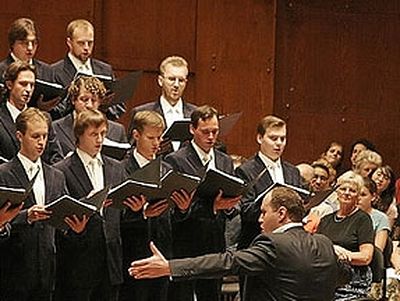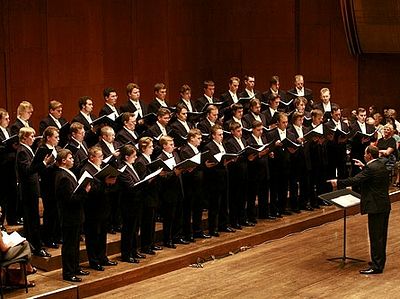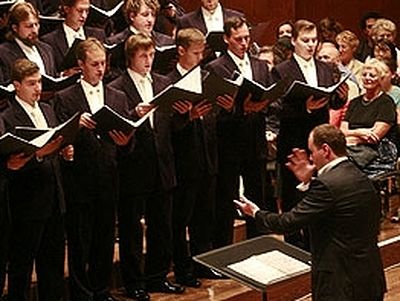Tuesday September 11, 2007
It’s 6pm at Moscow’s Sretensky Monastery and the faithful are arriving for prayer. Inside the church, women wearing headscarves genuflect beneath a vast altar as an orthodox priest in black rectangular headgear waves incense. Hundreds of candles illuminate the ancient frescoes.
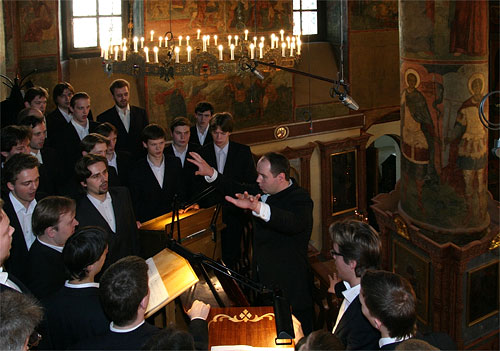 Sretensky monastery choir at its home base. Photo by M. Rodionov / Pravoslavie.Ru
Sretensky monastery choir at its home base. Photo by M. Rodionov / Pravoslavie.Ru
|
| Sretensky monastery choir at its home base. Photo by M. Rodionov / Pravoslavie.Ru |
Up in the gallery, a group of young men are standing round sheets of music. Several are dressed in seminarians’ robes; others wear denim jackets. One has a ponytail. Three have beards. Their average age is about 23. They seem much like any other choir – until they open their mouths. What emerges is a wave of extraordinary sound: rich, gripping, melodic, powerful and utterly unfeigned. It’s the sort of sound you might expect had the early apostles suddenly broken off from writing the New Testament and burst into song. Down below, the priest responds in resonant baritone; the glorious exchanges waft heavenwards.
That this choir is so good is not an accident. As the monastery’s youthful abbot, Father Tikhon, points out, it is made up of the “best voices in Moscow”, many from elite musical academies, and has a growing international reputation. Earlier this month, the Sretensky choir embarked on a world tour, singing in New York, Boston, Chicago, Washington, Sydney, Melbourne, Geneva and Berlin. The tour climaxes with a London performance on September 30. Reviews have so far been gushing. The 41 singers have mastered “the dense, nasal tone and luminous blend characteristic of Russian choral tradition”, the New York Times noted. It called one hymn, Now the Powers of Heaven, “achingly lovely”, and praised tenor soloist Anton Sergeev for his “dreamy ardour”. The audience, including many gentlemen in clerical robes, “appeared to be ready to listen all night long”.
As well as bolstering the choir’s reputation, the tour will introduce western audiences to an unusual range of Russian songs, both secular and religious, including a memorable Cossack meditation on the meaning of death. The programme also includes a few ancient Byzantine and classical liturgical pieces. But most of the performance isn’t religious as such, being made up of Russian folk-singing.
“There is a sacred aspect to Russian folk songs – they are often about death and suffering,” Father Tikhon explains, over a pot of tea in his comfortable residence. “One piece, The Black Raven, is a sort of dialogue with death. It’s about a Cossack soldier going off to battle knowing he is going to die. He speaks of how a bullet will pierce his chest, how his comrades will leave him, and how his wife will marry his best friend. His bones will be scattered across the steppe by wolves and ravens.”
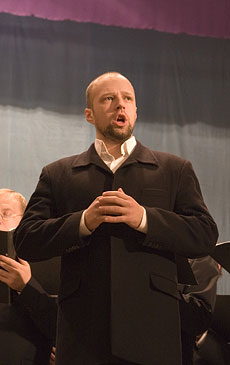 Bass soloist D. Beloselsky is singing “Brothers, It’s Good to Live”
Bass soloist D. Beloselsky is singing “Brothers, It’s Good to Live”
|
| Bass soloist D. Beloselsky is singing “Brothers, It’s Good to Live” |
Isn’t this rather depressing? “Not at all. It’s about victory over death,” Father Tikhon says. “It’s not pessimistic. There is no depression involved. It’s an extremely realistic view of life and death – if you believe in God.” He adds: “There is a rich tradition in Russia of romances and songs, especially in Soviet times when church music was forbidden. In an atheistic regime, prayerful feelings are sublimated into music.”
The choir’s 40-odd singers are all gifted young professionals. Some are seminarians studying to become priests; as well as singing for several hours a day, they listen to lectures by outside professors, take ecclesiastic lessons, and tend the monastery’s bucolic gardens. Others are students at the Moscow conservatory and other elite musical academies. One, Fyodor, is a talented composer. All are orthodox believers.
Sitting on a garden bench outside the monastery’s white-painted, multi-domed church, choir member Roman Alexandrovich Rodionov says he took up singing at the age of 10. A choirmaster in his hometown of Oryol spotted his talent. “He started teaching me to sing,” Roman, now 19, says. Why does he think the choir is so good? “Well, a lot of singers are graduates of the most famous music schools in Moscow,” he says. “But it’s also down to God’s help. Before and after every rehearsal we sing a prayer.”
Asked whether they would like to spend an extra day in Paris or an extra day in London, the choir unanimously chose London. Several, it turns out, are fans of Sherlock Holmes. “When I hear the word London, I immediately think of red buses, Big Ben and tea with milk,” Roman says. “When I was at school, I never dreamed I would ever go there.”
In fact, the Sretensky monastery singers are a well-travelled bunch. They have already sung at Notre Dame cathedral in Paris as well as at the Vatican Hall auditorium and in Belgrade. They frequently take part in services in Moscow conducted by Russia’s Patriarch, His Holiness Alexei II, at the Dormition cathedral, an exquisite 15th-century church inside the high walls and forbidding towers of the Kremlin.
The tour isn’t about selling CDs, although the choir has produced several, but about the reunification of Russia’s divided orthodox church. In May, the church inside Russia was reunited with the Russian orthodox church abroad, a ground-breaking event marking the end of nine decades of division triggered by the Bolshevik revolution. (The church inside the country had reluctantly recognised the new communist government; the church abroad never did.) As well as the concerts, the choir will take part in services in orthodox churches around the world celebrating this.
Founded in the 14th century, the Sretensky monastery reflects Russia’s entire history: wars and revolutions, fiery prayer and unbridled militant atheism. After the 1917 revolution, the new government installed a pro-communist sect in the buildings. In 1925 it was closed. The monastery’s superior, Archbishop Hilarion, was sent off to a gulag where he perished. In the 1930s, officers belonging to Stalin’s secret police were billeted here, and numerous executions were carried out in the monastery’s leafy grounds. The church got its buildings back in 1991; the choir was formed three years later.
Today, the monastery is an oasis of tranquillity in the centre of brash, capitalist Moscow. Outside, young women wearing designer sunglasses nudge absurdly large black Jeeps through traffic-choked avenues. According to Father Tikhon, though, despite such ostensible Godlessness, the Russian orthodox church is now enjoying a remarkable renaissance in Russia, with 500 churches in Moscow, compared to 40 in the 1980s.
At the church, the last worshippers are crossing themselves and preparing to head home. Another reason the choir is so good, Father Tikhon says, is that they are not interested in worldly success or money. “It’s like early Christianity, like apostolic times,” he says. “The most important thing in life is their belief in God. They see the world as it is. But they can live in the world and still retain their Christianity”.
The Moscow Sretensky Monastery Choir is at the Cadogan Hall, London, on September 30. Box office: 020-7730 4500.
